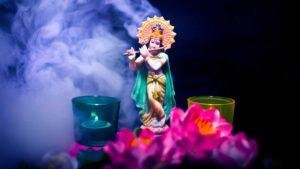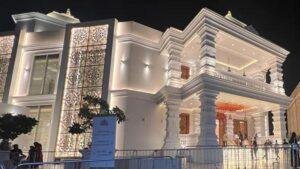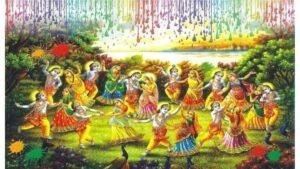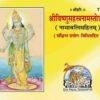Enter Dwarkadhish Temple’s ethereal realm now! This historic Hindu temple is a remarkable wonder and is situated in the thriving Gujarati city of Dwarka. It is a widely respected location that receives a huge influx of worshippers and visitors each year due to their devotion to Lord Krishna.
Dwarkadhish Temple boasts a fascinating history that spans thousands of years, leaving behind a trail of myths, legends, and unsolved mysteries. Its religious and cultural significance is undeniable, capturing the hearts of scholars, historians, and believers alike.
Our journey takes us into the depths of Dwarkadhish Temple, where we’ll uncover hidden stories, unexplained phenomena, and archaeological wonders. Legends speak of Lord Krishna’s divine presence here, and rumors whisper about secret chambers and underground passageways. These enigmatic tales provide a captivating glimpse into the past, revealing the enduring beliefs that have shaped this temple’s legacy.
So, come along as we explore the concealed mysteries of Dwarkadhish Temple. We’ll trace its historical roots and understand the profound impact it continues to have on devotees and pilgrims from all corners of the globe.
Explore the Origins of Dwarkadhish Temple:
1. Ancient Mythology:
Dwarka’s ancient roots trace back to Hindu mythology, found in the epic of Mahabharata. The story tells of Lord Krishna, who settled in Dwarka after the great Kurukshetra War, establishing it as his kingdom. People often refer to this place as “Dwarka Dham,” considered sacred for Hindu pilgrims.
2. Historical Records:
Beyond its mythical significance, Dwarka appears in various historical texts. The Vishnu Purana and the Harivamsa, ancient Hindu scriptures, detail Lord Krishna’s reign in Dwarka and the city’s construction during his time. Historians mention that Dwarka was an important port and trade city in ancient times.
3. Archaeological Findings:
Once believed to be a mere legend, the existence of ancient Dwarka gained credibility through extensive archaeological excavations in the late 20th century. Led by the renowned archaeologist Dr. S.R. Rao, these findings provided compelling evidence of a submerged city off Dwarka’s coast, reaffirming its historical importance and association with Lord Krishna.
4. Temple Construction:
The current Dwarkadhish Temple exemplifies ancient Hindu temple architecture. Believed to have been built around 2000 years ago by Vajranabh, Lord Krishna’s great-grandson, the temple underwent renovations and reconstructions over the centuries, with the present structure dating back to the 16th century.
5. Patronage by Rulers:
Throughout history, various rulers and dynasties supported and patronized the Dwarkadhish Temple. Kings from the Maurya, Gupta, Chavda, Solanki, and Vijayanagara empires contributed to its development and endowments.
6. Spiritual Significance:
For millions of Hindus worldwide, the Dwarkadhish Temple holds profound spiritual significance. It is among the Char Dham pilgrimage sites in India, a group of four holy destinations that Hindus aspire to visit in their lifetime. Devotees from all over the country flock to the temple, especially during festivals like Janmashtami, celebrating Lord Krishna’s birth.
The historical background of the Dwarkadhish Temple weaves together mythology, history, archaeology, and spirituality, making it a vital part of India’s rich cultural and religious heritage.
Architectural Marvels

The Dwarkadhish Temple is famous for its amazing architecture, showcasing the rich cultural and artistic heritage of ancient India. The temple has a blend of different styles, making it a significant attraction for devotees and art lovers. Let’s explore the fascinating features of the Dwarkadhish Temple:
- Impressive Structure: The Dwarkadhish Temple is a stunning five-story building known as the Jagat Mandir. It’s mainly made of limestone and sand and stands tall at 51 meters (167 feet). As you approach the temple, you’ll be captivated by its grand entrance with a huge, intricately-carved arch.
- Exquisite Carvings: Outside the temple, you’ll find beautifully detailed carvings and sculptures depicting scenes from Hindu mythology and Lord Krishna’s life. These carvings showcase divine acts, battles, and interactions with devotees, reflecting the incredible skills of ancient Indian artisans.
- Beautiful Dome and Spire: The temple has a magnificent dome adorned with intricate carvings, supported by pillars that display impressive engineering. On top of the dome, there’s a striking spire (shikhara) that adds to the temple’s grand appearance.
- Halls and Pavilions: Inside the temple complex, you’ll find various pavilions and halls, each with its unique design and purpose. The main hall, called Rang Mahal or Sabha Mandap, is where devotees come together for prayers and religious ceremonies. These halls have artistic pillars and ceilings, showcasing the talent of ancient Indian architecture.
- Sacred Shrine: At the heart of the temple, you’ll find the main deity, Lord Dwarkadhish (Lord Krishna), in a beautifully adorned shrine. The deity, usually made of black stone, is dressed with intricate jewelry and garments. This sanctum is a place of great spiritual significance, where devotees offer prayers and seek blessings.
- Well-Planned Layout: The layout of the Dwarkadhish Temple is carefully designed to accommodate a smooth flow of devotees during busy pilgrimage seasons. The spacious courtyard and organized pathways allow visitors to move around the temple complex comfortably.
- Artistic Pillars: The temple boasts a remarkable collection of pillars and columns, each featuring unique carvings and motifs. These pillars not only provide support but also showcase the artistic talent of the craftsmen from that era.
- Ancient Techniques: Researchers and engineers have been fascinated by the construction techniques used in building the temple. The precise stone masonry, the use of interlocking stones without mortar, and the alignment with astronomical phenomena all contribute to the temple’s architectural marvel.
The architectural wonders of the Dwarkadhish Temple reveal the advanced skills and artistic brilliance of ancient Indian artisans. The temple’s structure, carvings, and designs offer a glimpse into the region’s rich history and cultural heritage, leaving visitors from around the world in awe and inspired.
Legends and Myths of Dwarkadhish Temple:
The Dwarkadhish Temple holds fascinating tales and myths that have been passed down through generations, adding to its mystical aura and significance in Hindu mythology. Let’s explore some of the prominent stories linked to the temple:
1. Lord Krishna Establishes Dwarka:
A central myth is about Lord Krishna establishing the city of Dwarka. After the great Kurukshetra War, he moved from Mathura to build his kingdom on the banks of the River Gomti, fortified with massive walls.
2. The Sunken City of Dwarka:
According to ancient texts, Dwarka met its end after Lord Krishna’s departure, as it got submerged in the sea due to a massive flood. This earned it the name “Swarnadwarka” or “Dwarka of Gold.” Archaeological finds off the coast have sparked debates about the sunken city’s existence.
3. The Sudarshan Chakra:
Another tale speaks of Lord Krishna receiving the powerful Sudarshan Chakra from Lord Vishnu. He used this divine discus to defeat demons and protect Dwarka from threats.
4. The Miraculous Deity:
The current Dwarkadhish Temple houses the idol of Lord Krishna as Dwarkadhish, adorned with jewels and clothes. Legend says the idol was initially worshipped by Lord Krishna’s great-grandson, Vajranabh, and later rediscovered and enshrined by Vallabhacharya, a Vaishnava saint, during the 16th century.
5. The Mysterious Disappearance of the Deity:
The departure of the deity is described in an interesting story. The idol was removed to preserve it during an invasion in the 17th century. Before being transported back and placed in the temple during the 19th century, it was hidden for over a century.
6. Connection to Lord Rama:
Some myths suggest a connection between the Dwarkadhish Temple and Lord Rama. It is believed that after rescuing his wife Sita from Ravana, Lord Rama visited Dwarka and worshipped Lord Krishna.
These captivating legends have made the Dwarkadhish Temple a must-visit destination for pilgrims and devotees seeking spiritual solace and divine blessings. The fusion of history and mythology adds to the temple’s enigmatic charm.
Rituals and Traditions
“Rituals and Traditions” explores the special religious practices and customs followed within the temple. These rituals are an essential part of the temple’s spiritual importance and are deeply rooted in Hindu beliefs. Here’s a closer look at this section:
I. Rituals at Dwarkadhish Temple:
A. Daily Worship: Every day, the priests perform special ceremonies to worship Lord Dwarkadhish, following a set schedule and traditional guidelines.
B. Aarti: A significant ritual where devotees offer lit lamps to the deity while singing hymns in praise of Lord Krishna. This creates a spiritual atmosphere.
C. Abhishekam: The idol of Lord Krishna is bathed with sacred substances like water, milk, honey, and more. It symbolizes cleansing and devotion.
D. Offering: Devotees offer various food items to the deity, and the blessed food (prasad) is later distributed among them.
II. Traditions at Dwarkadhish Temple:
A. Festivals: The temple celebrates major Hindu festivals like Janmashtami, Diwali, and Holi with great joy and special rituals.
B. Rath Yatra: The temple organizes a grand chariot procession where the idol of Lord Krishna is paraded through the streets, attracting thousands of devotees.
C. Pilgrimage: Dwarkadhish Temple is one of the four holiest pilgrimage sites for Hindus, and people undertake difficult journeys to seek blessings.
D. Chhappan Bhog: Lord Krishna is offered a sumptuous feast with 56 food items, symbolizing abundance and fulfillment.
E. Panchamrit Snan: On specific occasions, the idol of Dwarkadhish is bathed with a mixture of milk, curd, honey, ghee, and sugar, believed to bring divine blessings.
Overall, the section on “Rituals and Traditions” showcases how the religious practices at Dwarkadhish Temple contribute to its spiritual aura and cultural significance.
Conclusion
The Dwarkadhish Temple is an extraordinary symbol of devotion, mystique, and cultural heritage. Its intriguing secrets, steeped in mythology and history, captivate and inspire both pilgrims and scholars. The temple’s magnificent architecture, ancient rituals, and stories of Lord Krishna’s divine presence create a unique bond with millions of devotees worldwide. Its legacy as a sacred pilgrimage site will continue to fill the hearts of generations to come with awe and reverence.



















Add comment